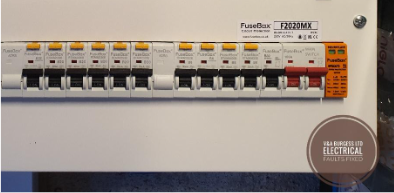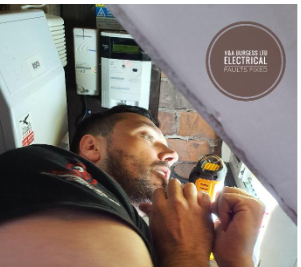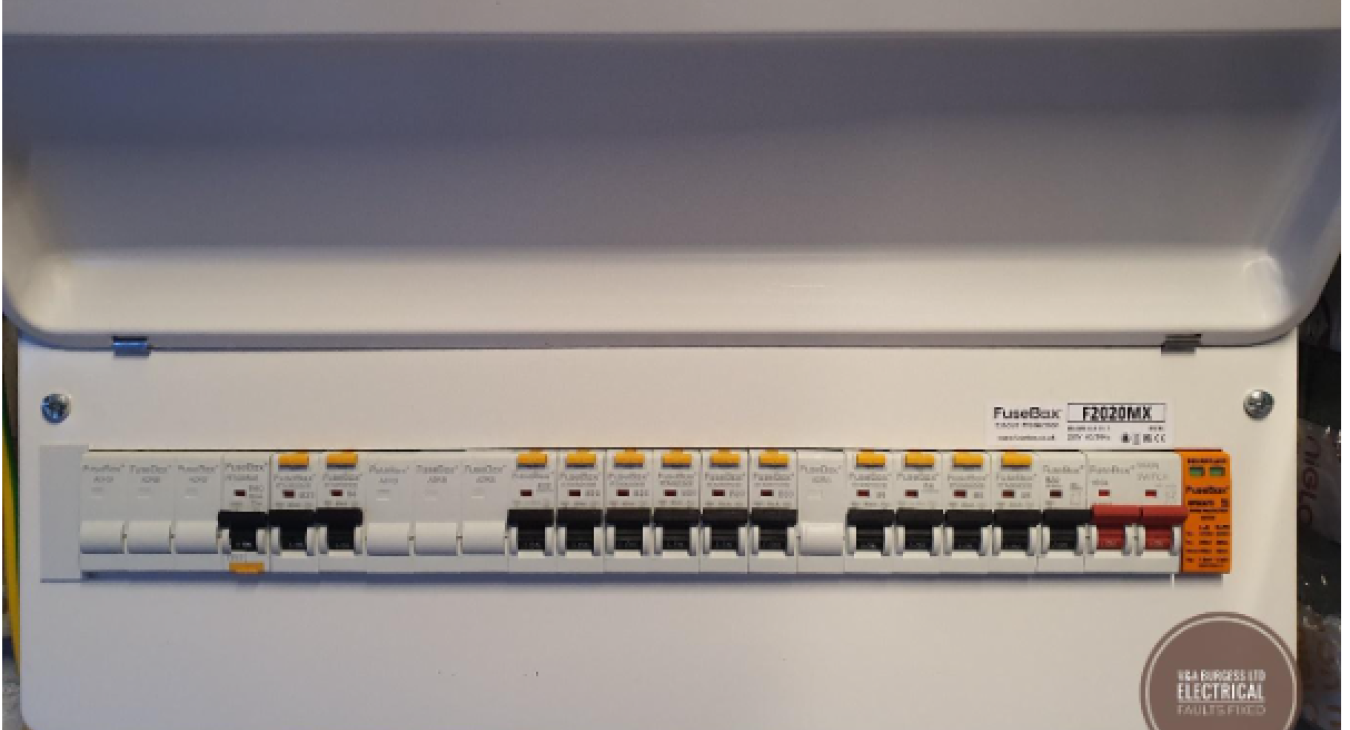What Home Consumer Unit do I need? The Guide 2024 - Electrical Faults Fixed
When your consumer unit or fuse box needs to be replaced there are some fantastic new features on modern consumer units that offer excellent protection against electric shock, overload, electrical fires, arcing and sparking and much more. There are many different parts to a consumer unit so it’s a good idea to familiarize yourself with them.
In 2024 the most up to date consumer unit offers cutting edge safety features that you cannot afford to miss out on. WHAT CONSUMER UNIT DO I NEED? Let’s see….
Things to look for when considering a new consumer unit are:
- Metal Construction
- RCBO individual trips vs DUAL RCD set up
- AFDD protection
- Surge Protection
- Spare ways for future upgrades
- Correct types of electric shock protection devices for your home
It is absolutely vital that you find a qualified electrician to guide you through the process of your replacement domestic consumer unit. Without an electrician to install your unit for you there will be no safety electrical testing, no paperwork, no building control notification, and no guarantee of safety.
Let us look at the features that new consumer units have
Back to top1) Metal Construction
All modern consumer units now need to be constructed from a non-combustible material and this is usually metal. Metal offers a durable and reliable material to contain the brains of your electrical system and is unlikely to fracture like plastic consumer units or become brittle over time.
Metal is also not able to catch fire like a plastic consumer unit would so there is a greater aspect of safety over wooden or plastic fuse boxes. In the UK, all wooden fuse boxes were common in the 1920s – 1930s and were eventually replaced with a wooden backed fuse box rather than all wood construction.
If you still have an all-wooden fuse box in your home then it is highly likely that the wiring and fuse box are no longer safe and you should consult an electrician to have an electrical safety check carried out.
Outdated consumer units can hide many potential dangers and will not necessarily operate for potential hazards in the electrical system. A short circuit is normally dealt with by most consumer units and fuse boxes but a modern consumer unit will also be able to detect earth leakage, electrical shocks occurring, power surges and quite possibly any severe risk of an electrical fire.
Back to top2) RCBO individual trips VS Dual RCD set up
For several decades now, we have had a special kind of trip switch installed in consumer units. These are called an RCD or Residual Current Device if your prefer the wordy version.
These devices are designed to protect us from electric shock and are a VITAL part of any home electrical installation.
In relatively modern consumer units, there are TWO RCDs. Each will protect half of the electrical circuits in the home. These devices should be tested regularly by YOU and occasionally by an electrician for a more in-depth test.

(DUAL RCD CONSUMER UNIT)
Each RCD is usually twice the width of a normal switch and has a test button on the front of the device. The test button should trip the device when pushed. If it does not, call an electrician to have the device checked and replaced if necessary.
The most up to date form of RCD protection is the RCBO device. This device is the width of a normal switch but contains an RCD. These devices are a great advantage over the DUAL setup because they minimize inconvenience whenever there is an electrical fault. They will only disconnect the power to one electrical circuit.
The RCBO contains an RCD and ALSO carries out the job of a traditional circuit breaker. They are slightly more expensive than a DUAL RCD setup but are the best way of ensuring compliance with the wiring regulations.

(RCBO CONSUMER UNIT WITH SPD)
The photograph above shows an RCBO consumer unit. Each device has its own test button.
Back to top3) AFDD Protection
These devices are an Arc Fault Detection Device. They detect dangerous electrical arcing where cables may be damaged, poor connections are lurking or short circuits may be beginning to occur. They are the earliest form of protection against electrical issues and can prevent fires in some cases.
The technology is new and expensive in 2024 and as such I would not YET recommend installing these devices unless the construction of the property specifically demands it (think thatched roof or wooden framed). Once the technology has been around a little longer and any tech issues have been ironed out, these devices will be a great addition to any electrical installation and will also drop a little in price too.
Back to top4) Surge Protection
As the name would suggest, the surge protection device protects the electrical installation, appliances and wiring from any higher-than-expected voltages or surges in supply voltage. The excess voltage is diverted to earth saving excessive wear and tear on equipment and preventing premature failure from excessive voltage damaging delicate circuit boards in modern electrical appliances.
These are a great addition NOW in 2024. They are relatively inexpensive if installed as part of a replacement consumer unit and are a bit of a no brainer. They are not mandatory under the regulations yet but it may be on the horizon.
If you would like surge protection installed but have an older consumer unit which is not due for replacement then your electrician may be able to install a standalone surge protection device on the incoming power supply for you.
5) Spare ways for future upgrades
Each slot in a consumer unit that is available for an electrical circuit is known as a ‘way’. It is always a good idea when replacing a consumer unit to have a sufficiently large unit installed such that there are spare ways available for any future upgrades that may be required.
Where there are no spare ways in a consumer unit it is often necessary to install an additional smaller consumer unit near the original to power the additional equipment. This is not always necessary due to lack of space and as such, installing a larger unit in the first place may have been the best way.
Are all electric shock protection devices the same???
Back to top6) Correct types of electric shock protection device for your home
There are several different types of RCD (electric shock protection device or residual current devices) available on the market and each has a specific purpose. The unit pictured below has the most basic form of RCD and these are quickly becoming outdated in our modern homes.
These devices have performed brilliantly for years but now we require an upgraded version to cope with all the DC (direct current) circuitry that is contained within LED lamps, modern electrical appliances, computers and more.
Your electrician is the best person to speak to regarding the type of RCDs that your home will require. Each home may be slightly different and your electrician will discuss your needs with you.
Back to top7) What are the Main Types of Consumer Units?
There are a few different types of consumer unit that are still available on the market today.
These offer various benefits and drawbacks but your electrician will be able to determine which type is most suitable in your electrical installation.
- Dual RCD consumer unit
- High-Integrity Consumer Unit
- Main Switch Consumer Unit with RCBOs
The Dual RCD consumer unit offers little flexibility in the event of a fault and will mean that half of the electrical circuits in the property will be affected immediately. There is a good chance that an electrician will need to attend in order to trace the issue and rectify the fault. The issue may be deemed an emergency if you lose power to the boiler, sockets and cooking facilities all at the same time.
The High-Integrity Consumer Unit is a Dual RCD consumer unit with spare ways to allow the installation of RCBO devices. This offers a little more flexibility and allows for important circuits to be protected by RCBO to minimise any inconvenience that may occur during an electrical fault. This type of consumer unit also allows for a circuit to be installed without RCD protection meaning that further consumer units can be added in outbuildings and garages with their own individual RCD or RCBO setup.
The Main Switch Consumer Unit is the ultimate in technology and convenience for most domestic households. In the event of an electrical issue, there will normally only be ONE electrical circuit that trips off making fault finding quicker, easier and less expensive to hire an electrician for.
Back to top8) Summary
If you are looking for a new consumer unit in 2024 and are asking WHAT CONSUMER UNIT DO I NEED? then by far the best type will be a Main Switch Consumer unit. This type of consumer unit allows for the installation of RCBOS and AFDD devices allowing you the most modern technology to protect your home and family.
The legal requirements for installation of a consumer unit in a domestic property are a building control notification regarding the work. This type of work is a notifiable job and also carries the need for an electrical installation certificate from your electrician.
An electrical system in good condition should not have many issues but nevertheless it is a good idea to have a periodic inspection carried out beforehand by your electrician to ensure there are no nasty faults or expensive surprises in store.
Back to top9) Most Commonly Asked Questions
9.1) Can a consumer unit be installed close to the floor?
Floor level consumer units are no longer installed in new homes as they do not comply with the up to date building regulations. If your own electrical consumer unit is installed in a difficult to access location such as close to the floor, it doesn’t meet modern building regulations.

(Electrician in Small Cupboard on the Floor)
This does not mean it has to be moved. If a replacement consumer unit is installed it may be installed in the same position as the old one. The main reason for the change is down to part M of the building regulations. This part of the regulations ensures that electrical equipment is accessible for maintenance, inspection and of course, resetting a tripped circuit breaker in the event of an issue.
9.2) What are miniature circuit breakers?
Miniature circuit breakers are a type of trip switch that may be found in an old fuse board or a modern consumer unit. These electrical components will each monitor the electrical currents flowing around a circuit. There should be a miniature circuit breaker (or modern equivalent) for the sockets, one for the lights, one for the electric cooker and so on.
These devices are designed to protect against situations in electrical installations where too much power is being consumed on a circuit or when there is a short circuit type fault. They can get rid of a massive electrical currents when needed and will sometimes operate with a bang!
9.3) Is a crackling sound from older units normal?
NO. A crackling sound from the consumer unit is an indication that there may be electrical arcing occurring. This puts the entire power supply at risk as, if a fire develops as a result of the high temperature arcing, it is likely to destroy and old fuse box and severely damage a modern consumer unit.
Have any strange sounds like this checked by a professional electrician immediately
9.4) Is a plastic unit illegal?
The best consumer unit is a metal construction. There are still many plastic consumer units out there doing a great job and they are certainly not illegal. It is simply against regulations to install a replacement consumer unit that is plastic.
9.5) What is the best consumer unit?
There are several great brands out there and your electrician will choose the best one for your circumstances. Good brands include:
- Fusebox
- Hager
- Wylex
And many more.
Most consumer units come with a good warranty and should outlast a gas boiler twice over making a new consumer unit incredible value!
Read more articles
- Log in to post comments


